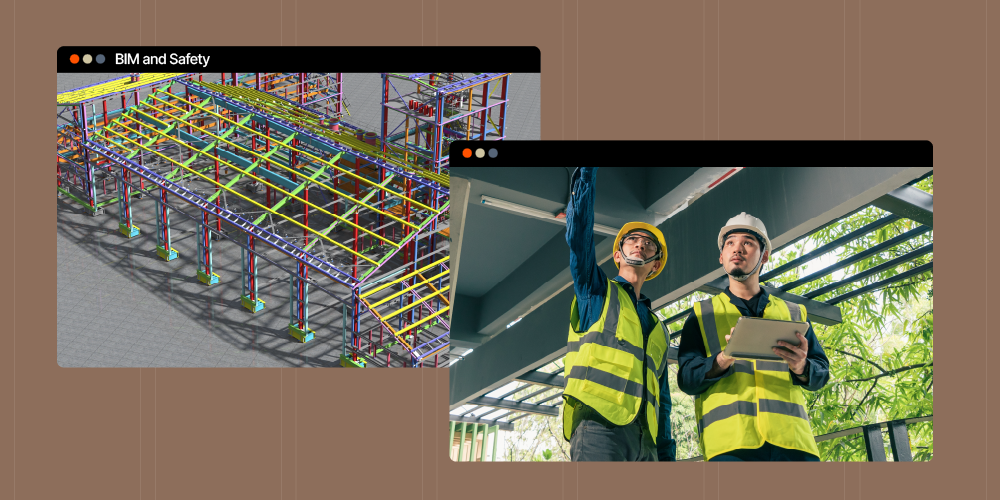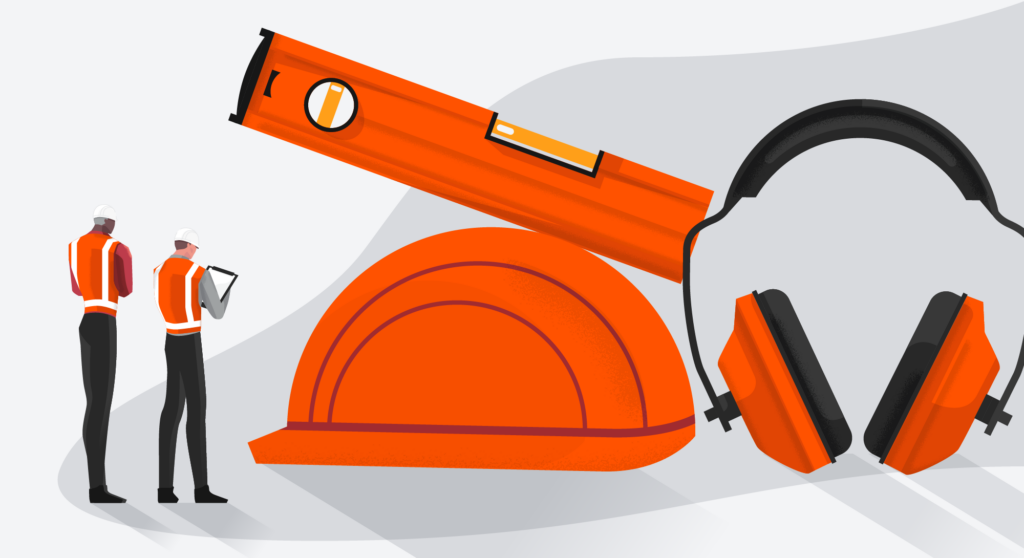— 9 min read
Annual Crane Inspections: Preparing & Passing
Last Updated Sep 1, 2024
Last Updated Sep 1, 2024

When it comes to heavy lifting on construction sites, cranes are the real workhorses — towering over jobsites and hoisting materials upwards of 1,000 feet.
These giants should be kept in top-notch condition, which requires frequent inspections and updated records by site leadership and safety teams. Additionally, adhering to safety regulations and passing annual crane inspections are necessary to keep this heavy equipment in operation.
In this article, we’ll dive into what it takes to prepare for and pass annual crane inspections, and how to safely get cranes back into operation if they’ve been called out of service.
Table of contents
Preparing for an Annual Inspection
Yearly crane inspections serve as an audit of the safety checks and maintenance that should be conducted on a regular basis. Responsible equipment management, maintenance and clear and organized documentation help to lay the groundwork for a successful inspection.
Before scheduling the inspection, a third-party auditor may request the following information about the equipment:
- Crane capacity and height
- Manufacturer details
- Usage rates
- Presence of manlifts
- Site and safety protocols
Organize equipment documents.
Documents and logs should be readily available to provide to the third-party inspector. Any records taken throughout the year should be updated, organized and made easily accessible by site leads or safety personnel. The following is a list of typical documents that should be maintained for crane inspections.
Annual Inspection Report
The previous year’s inspection should be posted on the crane.
Daily Inspection Logs
Detailed maintenance and inspection records to ensure all required checks have been performed and documented properly.
Maintenance Records
Comprehensive logs of all maintenance activities, including routine servicing, repairs and part replacements should be included.
Operator Certifications
Copies of the crane operator certifications from accredited organizations to verify operators are qualified to operate the crane. These certifications should also be posted on the crane at all times.
Load Test Results
Include documentation of periodic load tests that show the crane can lift its rated capacity.
Safety Device Logs
Record logs verifying that all safety devices such as limit switches and load indicators, have been tested and are functioning correctly.
Incident Reports
Thorough incident reports include documentation of any accidents, incidents or near-misses involving the crane, along with investigation findings and corrective actions.
Transparency about the equipment’s history and current condition helps jobsite teams, crane operators and inspectors on the same page with compliance and keeping the jobsite secure for everyone,
The Crane Inspection Process
Annual comprehensive crane inspections are required in order to comply with state and local regulations set by the Occupational Safety and Health Administration (OSHA). OSHA crane standards outline a comprehensive set of rules and regulations for safe crane operations and accident prevention.
Annual Inspections
Cranes undergoing inspection are either taken to a designated location, or the inspector visits the site where the crane operates. During the inspection, a third-party inspector may spend several hours going through all aspects of the crane.
Inspectors check cranes with a fine-toothed comb. They’ll examine the crane’s functionality, including the weld points and stress on the arm, as well as the cabling for signs of stress. They also check for deformed, cracked or corroded members of the crane, and review the hoisting and lowering mechanisms. This includes inspecting the trolley travel and bridge travel limit switches, and examine the locking and safety devices. Performance load tests are also conducted to ensure the crane can lift its rated capacity.
Pro Tip
The inspector may bring someone to assist them with two-person tasks like cabling up and down, and boom swinging.
Inspectors also look for loose bolts, rivets, sheaves and drums that may be cracked or worn out. They assess the condition of bearings, shafts, gears, and braking systems, as well as check the wind indicators, fuel systems, and electrical components, including limit switches. A crane inspection checklist is helpful for both operators and inspectors to have insight on what needs to be in compliance with state and local regulations.
Free Download
Crane Inspection Checklist
This free crane inspection checklist can be helpful to both operators and inspectors. It can be customized with items related to specific state and local regulations for any project.
- Free starter template with common inspection items
- Add custom checklist items for any project
- Trusted by construction professionals


Working with Third-party Inspectors
Third-party inspectors must be licensed and approved from an independent crane company, or certified with accreditation from a qualified organization such as the National Commission for the Certification of Crane Operators (NCCCO).
A thorough and detailed inspection by a third party verifies that any potential issues are identified and addressed, keeping the crane compliant with OSHA regulations and safe for operation.
Crane operators can 'tree' pieces of steel that they’re lifting. This means that rather than lifting one piece of steel at a time, there is an exception under the OSHA sub-part that allows operators to pick up five pieces of steel, all chained with different pieces of rigging to the main hook.
However, companies have sometimes tried to lift six or seven pieces because it seems more efficient. Even if the load isn't heavy, that's not what the OSHA standard permits. You have to follow the rule of lifting only five, and I've had to speak to crane operators about this.
Additionally, if something is out of compliance, like the time we noticed cracking in the arm of a crane, it needs to be addressed. Over time, due to fatigue and wear, a piece of machinery that's been lifting heavy loads its entire life will start to show metal fatigue or cracking. As it gets older, this is something that needs careful monitoring.
Clark Jensen
Strategic Product Consultant, Quality & Safety
Procore
How to Integrate Technology Into Crane Inspections
As technology advances, it continues to enhance the efficiency, accuracy and safety of crane inspections. Before the introduction of digital tools, crane inspectors manually inspected equipment, requiring physical access to all parts of the crane. This was both hazardous and time-consuming. Nowadays, technology has streamlined the crane inspection process in several ways.
Take advantage of remote monitoring.
Remote monitoring uses sensors and interconnected devices to continuously track and analyze the condition and performance of the crane. Real-time monitoring allows for immediate detection of an issue in load weight, wind speed, structural stress, and more.
Operators and maintenance teams can make informed decisions and swiftly handle issues through immediate feedback from the monitor. A third-party auditor will review these documents when conducting an annual inspection.
Use AR for real-time updates.
Augmented reality (AR) provides inspectors with enhanced visualizations and data during crane inspections. AR can be accessed through specialized glasses or through AR software downloaded on camera-equipped devices.
The operational data provided through AR can show real-time pressure readings, fluid levels and performance data. Inconsistencies are highlighted to point out potential issues. It can also provide historical data for comparison.
AR can also provide a step-by-step guided inspection. For example, when inspecting a crane’s boom, the AR glasses might display a checklist of specific areas to examine, such as joint welds or structural integrity. The AR glasses can connect an inspector to a remote expert for advice via video call, who can see exactly what the inspector is seeing through the AR glasses.
Stay updated on what’s happening in construction.
Subscribe to Blueprint, Procore’s free construction newsletter, to get content from industry experts delivered straight to your inbox.

Dealing with Failed Inspections or Crane Issues
Any issues identified during regular inspections should be addressed immediately. The problems should be properly documented, and if necessary, the crane should be taken out of service until repairs are made and verified by a third-party auditor.
There have been times when we had to take a crane out of service, not because of a catastrophic failure, but because it didn't meet all the requirements. For example, sometimes the glass was broken, or the outriggers weren't fully utilized as they were supposed to be, or there was an issue with the pads.
Typically, the crane has to push down onto outrigger pads to lift itself up, and some companies have tried to get away with using smaller pads or not extending them fully. This is out of compliance because the pads are meant to distribute the pressure on the surface area properly. We’ve occasionally had to take the crane out of service or at least address this issue with the operators.
Clark Jensen
Strategic Product Consultant, Quality & Safety
Procore
Take immediate action.
Any issues identified during regular or informal inspections should be addressed right away to prevent injury to the operator or anyone on, or near, the jobsite. If a crane is deemed unsafe, site leads or safety personnel should do the following.
Stop Operations
Cease all crane operations immediately to prevent further risk or damage.
Secure the Load
If safe to do so, secure and safely lower any load being lifted to avoid potential hazards.
Alert Personnel
Notify all workers in the vicinity of the issue to stay clear of the crane and any potential danger zones.
Lockout/Tagout (LOTO)
Implement LOTO procedures to ensure the crane is de-energized and cannot be operated until the issue is resolved.
Inspect the Crane
Perform an initial inspection to identify the nature and extent of the issue. This should be conducted by qualified personnel or a technician.
Report the Issue
Document and report the problem to the appropriate supervisory personnel or safety officer.
Engage Qualified Personnel
Arrange for a certified inspector or qualified maintenance staff to further investigate and address the issue, ensuring all safety protocols are followed.
Conduct Repairs
Carry out necessary repairs or maintenance tasks to rectify the problem, ensuring all parts and systems are restored to proper working condition.
Re-Inspect and Test
After repairs, perform a thorough re-inspection and functional test to confirm that the crane is operating safely and effectively.
Update Documentation
Verify that all actions taken, from initial identification to final testing, are documented thoroughly in maintenance records.
Resume Operations
Once the crane is confirmed to be safe and fully operational, lift the LOTO procedures and resume normal operations, informing all personnel that the crane is back in service.
Promptly addressing issues as soon as they pop up can drastically cut down the risks of catastrophic failures and potential injuries, making sure everyone goes home safe at the end of the day.
Consistency is Key to Passing Inspections
A successful annual inspection is often the result of meticulous care throughout the year. Regular maintenance checks, organized and accurate documentation and careful attention to protocols and compliance at all times can keep cranes in motion and prevent project delays or rework.
Keeping third-party inspectors in the loop on any issues with cranes in operation also helps ensure worker safety and that the project stays on track.
Was this article helpful?
Thank you for your submission.
100%
0%
You voted that this article was . Was this a mistake? If so, change your vote here.
Scroll less, learn more about construction.
Subscribe to The Blueprint, Procore’s construction newsletter, to get content from industry experts delivered straight to your inbox.
By clicking this button, you agree to our Privacy Notice and Terms of Service.
Categories:
Tags:
Written by
Clark Jensen
10 articles
Clark Jensen joined Procore as a Senior Strategic Product Consultant, Quality & Safety where he spearheads product knowledge education and executes product demonstrations. He brings several years of experience in roles both on and offsite as a former senior project safety manager for a general contractor in Salt Lake City, and a senior risk control consultant for a large U.S.-based insurance firm.
View profileMegan Duncan
Megan Duncan is an award-winning journalist based in Hannibal, Missouri. Her work has been featured on Muddy River News, Hannibal Courier-Post, The Whig, Hannibal Magazine, Q Magazine and Her View from Home. She has won two Best of Press Awards including first place from the Illinois Press Association for Localized National Story and third place from the Missouri Associated Press for best humor column. She holds a Bachelor of Arts in Communication from Quincy University.
View profileExplore more helpful resources

The Strategic Partnership Between Construction Safety and HR
A construction safety manager’s role is significant: It entails broad oversight over the construction workplace to prevent incidents that could cause worker injury or property damage. In addition to this...

Enhancing Construction Safety with BIM Technologies
The construction industry is no stranger to tools: Even ancient civilizations developed mallets and axes to make their work easier. Today’s latest tools look different, but they can be as instrumental...

Construction Safety Training – Goals, Benefits & Emerging Trends
Construction safety training (CST) educates workers about the risks they face on construction sites and teaches them how to prevent accidents, injuries and fatalities. The construction industry has the highest...

Technology for Construction Safety: Strategies to Supercharge and Scale Safety Practices
The construction industry is no stranger to the arrival of new technology, and builders are realizing its many benefits. Modernization across the industry is helping contractors streamline operations, enhance efficiency,...